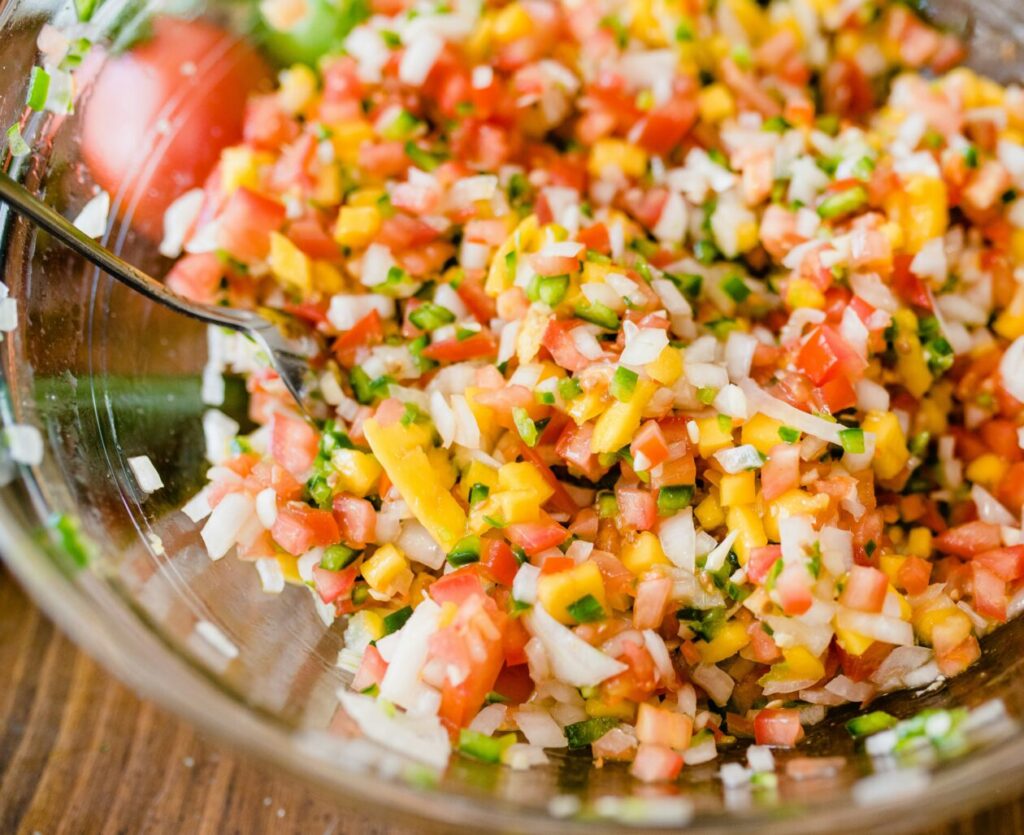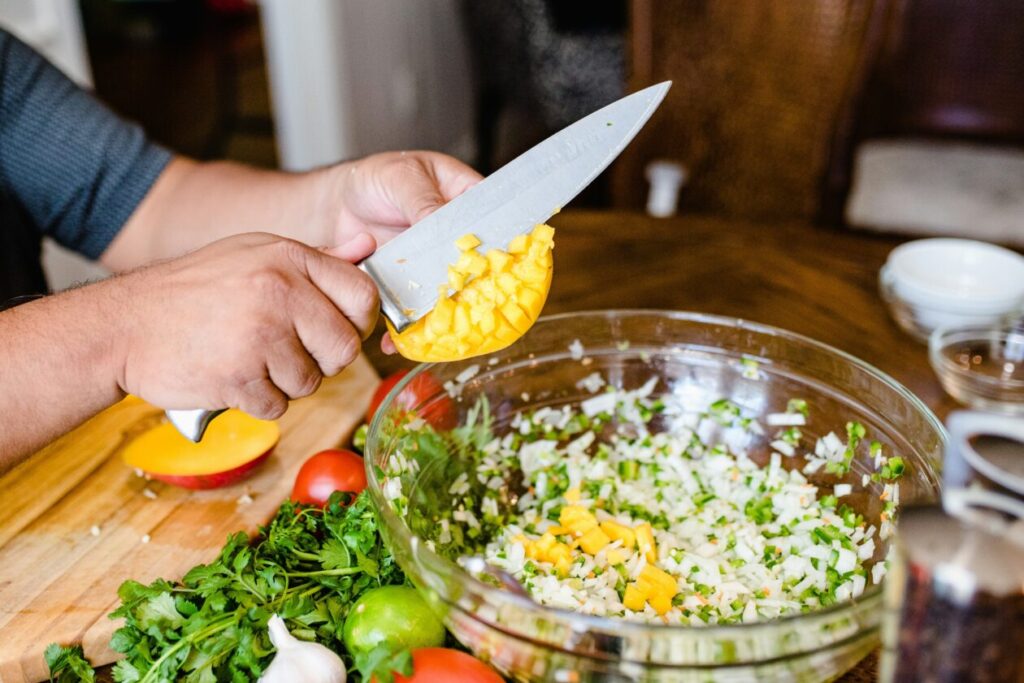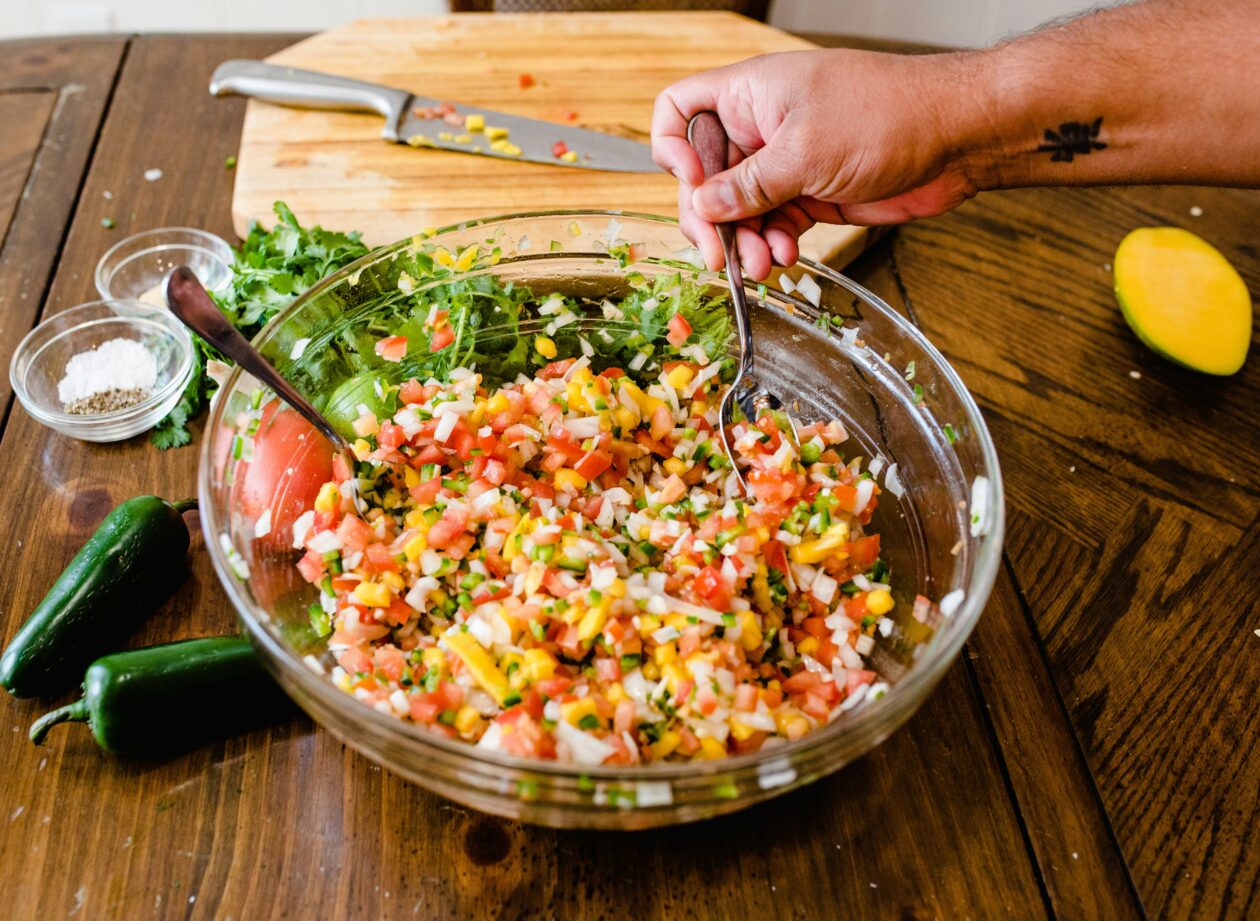Introduction
Pico de Gallo is a colorful, light salsa that has been loved for a long time for its fiery flavors and adaptability. Made up of chopped tomatoes, onions, cilantro, jalapeños, and lime juice, it’s a mainstay of Mexican cooking that gives a zesty boost to various meals. Apart from its taste, a fascinating query frequently arises: is pico de gallo good for weight loss?
I was raised surrounded by the diverse flavors of Mexico, so I have a special place in my heart for pico de gallo. Its appearance on our family table was more than simply flavor—it celebrated life and health. Investigating pico de gallo’s possible benefits for weight loss is a personal and gastronomic trip.
Let’s now explore the alluring options. Pico de gallo has attracted interest from health advocates due to its nutrient-dense components and low-calorie count. The combination of metabolism-boosting tomatoes and metabolism-enhancing jalapeños piques curiosity. Are these components merely delectable garnishes, or can they hold the secrets to a more health-conscious way of living?
What is Pico de Gallo?

Pico de Gallo is essentially a colorful, nutrient-dense salsa from Mexican food. The name, which means “rooster’s beak” in Spanish, alludes to the vibrant and tangy characteristics of the salsa. Typically, this tasty combination consists of diced tomatoes, onions, cilantro, jalapeños, and a squeeze of lime juice. Its simplicity makes it beautiful, presenting a harmonious blend of flavorful, fresh ingredients that entice the palate while potentially providing health advantages.
While pico de gallo and salsa seem similar, they have some small distinctions worth examining. With finely diced ingredients instead of combined, Pico de Gallo has a chunkier consistency than its saucier cousin. This contrast improves the overall experience and texture, making it a favorite condiment for people who value the distinct crispness of each bite’s constituent ingredient.
Knowing Pico de Gallo is more than just knowing its ingredients. The translation of “rooster’s beak” may seem odd, but it highlights the bite-like, strong flavor of the salsa. Acquiring the accurate pronunciation of “pee-koh deh guy-yo” would make your culinary talks seem more genuine. After reviewing the fundamentals, let’s explore the intriguing query: Is Pico de Gallo a hidden weapon for people trying to lose weight? This well-liked condiment’s nutritional profile and distinctive qualities may be the key to the solution.
Classic Pico de Gallo Recipe
Aside from being a gourmet experience, starting a weight loss routine using Pico de Gallo is also nutritional. Making this colorful condiment at home is easy and gives you complete control over the quality of the ingredients. Start with carefully diced ripe tomatoes, then add finely chopped onions and fresh cilantro. The key to its distinctive kick, the jalapeños, should be added with caution, according to your level of spice tolerance.
A squeeze of lime juice is necessary to improve the flavor profile because of its increased nutritional value and tang. Rich in vitamin C, limes are well-known for their ability to speed up metabolism. These components are carefully combined to create a mixture rich in nutrition and aesthetically pleasing.
There are a few key tricks to making your Pico de Gallo flawless. To preserve the perfect texture:
- Start by making sure your tomatoes are firm yet still ripe.
- Use fresh cilantro and chop it finely before combining to retain its flavor.
- Remember that most of the heat of jalapeños is concentrated in their seeds and membranes, so adjust for the desired level of spiciness.
You can customize the Pico de Gallo to your tastes by experimenting with the constituent ratios. This recipe’s versatility makes it an ideal partner on your weight loss quest. Its beauty resides in its adaptability.
Now that you know how to make Pico de Gallo, let’s look at inventive ways to use it in your dishes. In addition to being a traditional dip for tortilla chips, Pico de Gallo can be used as a low-calorie garnish for salads or a low-calorie topping for grilled chicken or fish. Its versatility also includes using it as a zesty topping for morning eggs or a vibrant and tasty addition to wraps. Pico de Gallo can become a delicious and nutritious mainstay in your weight reduction journey because the alternatives are as varied as your culinary creativity.
Health Benefits of Pico de Gallo Ingredients

A. Ripe Red Tomatoes
Selecting the right tomatoes is essential to making a delicious Pico de Gallo. Choosing ripe red tomatoes contributes to the bright flavor profile of this renowned condiment by ensuring the ideal mix of sweetness and acidity. The base is made of tomatoes, which give a superior Pico de Gallo its perfect texture and juiciness.
Not only are red tomatoes delicious, but they are also a nutritious powerhouse. They support general health and are packed with antioxidants, including lycopene, Vitamins A and C. Lycopene has been linked to several health advantages, such as heart health and possible anticancer effects. Including Pico de Gallo in your diet turns into a tasty and nourishing method to take advantage of the benefits of tomatoes.
B. Onion, Jalapeño, and Cilantro
In addition to adding flavor, the combination of onion, jalapeño, and cilantro in Pico de Gallo has significant health advantages. Onions are a great complement to any diet focusing on weight loss since they contain chemicals that may help with metabolism and weight loss. Known for their fiery flavor, jalapeños can increase metabolism and help activate brown fat, which may help burn calories. With its fresh, aromatic properties, cilantro balances this pair, adding flavor to the health-conscious trip.
Looking closer, we find these components have antioxidant qualities that help the body fight oxidative stress. Cucumber, with its special combination of antioxidants and onions, which are high in quercetin, supports the health of cells. Beyond their heat, jalapeños have an anti-inflammatory and pain-relieving compound called capsaicin. When combined, this trio from Pico de Gallo boosts your intake of nutrients while simultaneously tantalizing your taste receptors.
C. Lime
Lime gives Pico de Gallo a tangy touch, adding extra health benefits and increasing flavor. Lime juice’s zesty brightness enhances the flavor profile overall, making it feel revitalizing. Lime also helps to keep the dish’s vivid hues intact, which enhances its visual attractiveness.
Beyond taste, limes are high in vitamin C, an important vitamin with immune-stiffening qualities. Savor the flavor of Pico de Gallo and the boost to your immune system that this zesty garnish offers.
Using Pico de Gallo to incorporate these nutrients into your diet intentionally reveals a rich tapestry of flavors and health advantages. It’s a culinary ally, not just a condiment, on your wellness and weight control path.
Pico de Gallo Variations
A. Creative Variations Using Different Fruits and Vegetables
Renowned for its customary concoction of tomatoes, onions, jalapeños, cilantro, and lime, pico de gallo provides a platform for imaginative culinary experimentation. Changing from the traditional recipe allows you to enjoy various flavors and nutritional advantages. You add new flavors and nutritional value to your diet by including different fruits and vegetables, which also provide a range of vitamins and minerals.
B. A few variations (mango, corn, avocado, etc.)
Avocado Fiesta Blend: Add the creamy avocado richness to your pico de gallo. The sharpness of the conventional components is nicely contrasted with the buttery richness of avocado. Avocados, high in monounsaturated fats and aid in satiety, make this version tasty and filling.
Fiesta with Corn and Black Beans: bring corn and black beans to your Pico de Gallo to bring sweetness and earthiness. This version adds much plant-based protein and fiber and a hearty quality. Combining the two improves the flavor and makes your Pico de Gallo into a heavier topping or side dish.
Mango Tango Twist: Add chopped mango to your Pico de Gallo to give it a tropical flavor. Mango’s juicy and sweet flavor blends well with the other savory ingredients to create a cool and refreshing combination. Mango contributes to general well-being by offering a dosage of vitamins and antioxidants in addition to deliciousness.
C. How Variations Can Add Nutritional Value
In addition to their mouthwatering variety of tastes, these Pico de Gallo varieties offer special nutritional advantages. Avocado adds potassium and heart-healthy monounsaturated fats. Combining corn and black beans significantly increases fiber and plant-based protein, promoting satiety and digestive health. Mango’s high vitamin C and A content boosts your dish’s antioxidant profile, which supports healthy skin and a strong immune system.
Accept the flexibility of Pico de Gallo varieties to customize your eating experience to your tastes and dietary objectives. Not only can these inventive variations entice your palate, but they also include a wide variety of nutrients, which makes Pico de Gallo a flexible and health-conscious option for every situation.
Onion, Jalapeño, and Lime in Weight Loss

A. Overview of the Health Benefits of Onions
A basic ingredient in many kitchens and a key part of Pico de Gallo, onions add more to your food than just flavor. Onions, being high in anti-inflammatory and antioxidant components, are essential for maintaining general health. Onions are a low-calorie, high-fiber meal supplement to help you lose weight. The fiber content facilitates fullness perception, aids in digestion, and helps limit caloric intake. Additionally, onions feature a special antioxidant called quercetin, which may increase metabolism and help with weight management.
B. Jalapeños and Their Role in Weight Loss
Jalapeños provide a spicy bite that piques your interest and may also help individuals trying to lose weight. The chemical that gives jalapeños their spiciness, capsaicin, has been investigated for possible effects on weight and metabolism. According to some research, capsaicin may enhance fat oxidation and calorie expenditure, which could have a small but positive impact on weight loss. Including jalapeños in Pico de Gallo or other recipes can enhance taste without interfering with your diet’s weight loss objectives.
C. Citric Acid in Limes and Its Impact on Metabolism
Pico de Gallo’s zesty limes add more to the dish than just acidic freshness; they also provide a surge of citric acid. Numerous health advantages of citric acid have been linked to it, including possible impacts on metabolism. Although limes don’t directly help with weight loss, their citric acid may improve digestion and increase the overall effectiveness of metabolic processes. Furthermore, the vivid citrus flavor can enhance the flavor of your food, promoting a more pleasurable and long-lasting attitude to eating healthy.
When onion, jalapeño, and lime are discussed about losing weight, it becomes clear that Pico de Gallo’s ingredients are more than just delicious food. Each component’s distinct nutritional advantages enhance your general well-being. By incorporating these insights into your dietary decisions, use the potential harmony between these components and your weight control objectives.
Other Health Benefits of Pico de Gallo
A. Low-calorie content and weight management
Regarding tasty, low-calorie choices, Pico de Gallo is a nutritional powerhouse. Fresh tomatoes, onions, cilantro, and jalapeños are this colorful salsa-style dish’s main ingredients that taste great without packing on the calories. Pico de Gallo’s low-calorie content makes it a great option for those looking for weight loss assistance. You can enjoy flavorful foods that support your weight control goals by including this spicy condiment in your diet.
B. Hydration and water-rich ingredients
In addition to being a delicious sauce, Pico de Gallo’s high water content helps with hydration objectives. Cucumbers, tomatoes, and other ingredients add to the total water content, which helps keep the body hydrated. Drinking enough water is essential for several body processes, such as digestion and metabolism. Including Pico de Gallo in your meals helps you stay hydrated and tastes refreshing, which benefits your overall health.
C. Anticancer properties and lycopene content
Examining Pico de Gallo’s health advantages reveals more about the delicious flavor profile. The main ingredient in this salsa, tomatoes, have lycopene, a potent antioxidant with possible anticancer effects. Research has been done on lycopene’s ability to lower the risk of some malignancies and fight oxidative stress. Savoring Pico de Gallo enhances the flavor of your food and adds important antioxidants that could benefit your long-term health and well-being.
To sum up, Pico de Gallo is more than just a delicious food; it becomes a complex ally on your path to wellness. This tasty condiment offers several health benefits to your meal, including hydration-boosting qualities, potential anticancer benefits, and a low-calorie composition that helps with weight management. Discovering Pico de Gallo’s many facets, you find a tasty and health-conscious ally on your journey toward a well-rounded existence.
Is Pico de Gallo Good for Weight Loss?
A. Salsa as a Nutritional Powerhouse
In condiments, pico de gallo and salsa are the unsung heroes for weight loss. Salsa is a nutritional powerhouse that sticks out thanks to its colorful and fresh components, including tomatoes, onions, cilantro, and jalapeños. These ingredients give salsa taste and vital nutrients so you can enjoy it guilt-free with your meals. Compounds like lycopene, recognized for its possible function in weight management, are found in tomatoes used in salsa. You may enjoy the flavorful benefits of salsa, especially Pico de Gallo, while giving your body essential nutrients.
B. Comparison with Other Condiments
It’s critical to compare condiments while attempting a healthy diet and select those that will help you reach your goals for weight loss. In contrast to many condiments that are heavy in sugar and calories, salsa and pico de gallo provide a cool substitute. These condiments provide taste without sacrificing your dietary objectives. Choose salsa instead of other dressings or sauces to add a nutrient-dense, low-calorie option to your meals. The zesty flavor of Pico de Gallo especially lends flavor to your meals and helps you stick to your diet plan of eating a healthy, balanced diet.
C. Integration into a Healthy Diet for Weight Loss
It takes both what you put on and remove from your diet to navigate a weight loss path successfully. Salsa and pico de gallo can be quite helpful when trying to lose weight. They are a wise option for anyone trying to maintain a healthy weight because of their low-calorie content and various vitamins and antioxidants. Think about using Pico de Gallo as a spicy side dish, a tasty complement to salads, or a topping for grilled proteins. Adding these condiments to your diet improves taste and helps you develop a healthy connection with food while you lose weight.
Finally, salsa and pico de gallo are tasty allies on your weight loss journey, providing a delicious substitute for high-calorie condiments. When weighed against other dressings, their nutritional profile makes them a great option for anyone looking for a more palatable and healthful way to manage their weight. Savor the distinct flavors of pico de gallo and salsa while providing your body with healthy components. Savor the goodness of these foods.
Moreover, in response to the query, “Is Pico de Gallo good for weight loss?”—Indeed, Pico de Gallo is a great option if you want to lose weight. Because Pico de Gallo is made of nutrient-dense components like tomatoes, onions, cilantro, and jalapeños, it has a low-calorie count. It enhances flavor without making it difficult to achieve weight control goals. Pico de Gallo’s colorful and fresh ingredients make it a guilt-free, delightful choice to help you reach a healthier weight.
FAQs About Pico de Gallo
1. Is pico de gallo a healthy snack?
Absolutely! Pico de Gallo is an excellent choice for a healthy snack. Its fresh and wholesome ingredients, like tomatoes, onions, cilantro, and jalapeños, are low in calories while offering a burst of flavor. Dip your favorite veggies into this vibrant mix for a satisfying and nutritious snack.
2. Is it okay to eat pico de gallo every day?
Certainly! Pico de Gallo is okay and can be a fantastic addition to your daily meals. Its nutrient-dense composition, packed with vitamins and antioxidants, makes it a guilt-free and delicious choice to enjoy regularly.
3. Is pico de gallo healthy for your stomach?
Yes, it is. Pico de Gallo is generally gentle on the stomach with its fresh vegetables and minimal processing. Combining tomatoes, onions, and cilantro can contribute to a healthy digestive system.
4. Is pico de gallo low in calories?
Absolutely! Pico de Gallo is known for its low-calorie content. It adds flavor to your dishes without compromising your calorie intake, making it an ideal choice for those looking to manage their weight.
5. Is Pico healthy or unhealthy?
Pico de Gallo is undoubtedly healthy. Its combination of fresh ingredients provides essential nutrients, vitamins, and antioxidants, making it a wholesome and nourishing addition to your diet.
6. When should I eat pico de gallo?
You can enjoy Pico de Gallo at any time of the day. Whether as a topping for your morning omelet, a refreshing side for lunch, or a zesty addition to your dinner, Pico de Gallo is versatile and suits various mealtime occasions.
7. Can you just eat pico de gallo?
Absolutely! Pico de Gallo is flavorful enough to be enjoyed on its own. Scoop it up with tortilla chips or spoon it onto your favorite dishes for freshness and taste.
8. What is pico de gallo in English?
Pico de Gallo translates to “rooster’s beak” in English. It’s a traditional Mexican condiment with diced tomatoes, onions, cilantro, jalapeños, and lime juice.
9. What to pair with pico de gallo?
Pair Pico de Gallo with grilled chicken, fish tacos, quesadillas, or simply as a topping for salads. Its versatility complements a wide range of dishes.
10. What countries eat pico de gallo?
While Pico de Gallo originated in Mexico, it has become popular worldwide. Many countries, especially those who love Mexican cuisine, enjoy Pico de Gallo as a flavorful accompaniment.
11. Which is better, pico de gallo or salsa?
Both Pico de Gallo and salsa have their unique characteristics. Pico de Gallo is chunkier, with fresh, diced ingredients, while salsa is typically blended. The choice depends on personal preference and the desired texture.
12. Is Pico de Gallo good overnight?
Pico de Gallo is best enjoyed fresh for optimal flavor and texture. While it can be refrigerated, the ingredients may release water overnight, affecting its crispiness. It’s recommended to prepare it fresh for the best taste.
13. Pico de Gallo calories 1 cup
A standard 1-cup serving of Pico de Gallo typically ranges between 20 and 30 calories, making it a light and healthy choice.
14. How many calories in pico de gallo with avocado?
Adding avocado to Pico de Gallo increases the calorie count. On average, a cup of Pico de Gallo with avocado can range from 80 to 100 calories.
15. Is pico de gallo healthier than salsa?
Both Pico de Gallo and salsa have health benefits. Its fresh and diced ingredients make Pico de Gallo slightly healthier due to its minimal processing.
16. Is pico de gallo good for people with diabetes?
Pico de Gallo can be a good choice for people with diabetes as it is low in added sugars and offers fresh, whole ingredients. However, portion control is essential.
17. Calories in homemade pico de gallo
The calorie content in homemade Pico de Gallo can vary based on ingredient proportions. On average, a cup of homemade Pico de Gallo ranges from 20 to 30 calories.
18. Is pico de gallo high in sodium?
Compared to commercial salsas and dressings, Pico de Gallo is generally low in sodium. However, the sodium content can vary based on individual recipes.
19. Is pico de gallo healthy?
Yes, Pico de Gallo is a healthy choice. Its fresh ingredients provide essential nutrients, vitamins, and antioxidants, contributing to a well-rounded diet.
Conclusion
As our investigation ends, it is clear that Pico de Gallo is a nutritional powerhouse with many advantages, particularly for people trying to lose weight. This colorful and fresh condiment has minimal calories and a powerful flavor thanks to its main ingredients: tomatoes, onions, cilantro, and jalapeños. The mixture gives your dishes more flavor and provides vital nutrients that promote general health.
A game-changer in your quest for a better lifestyle is adding Pico de Gallo to your everyday meals. Its adaptability makes it a guilt-free option to add flavor to various foods, including salads and grilled chicken. The food’s nutrient-dense composition guarantees giving your body the vital vitamins and antioxidants it needs and tasting excellent cuisine. Make it a delicious complement to your well-balanced diet, adding health and satisfaction to every bite.
Reference
Pico de gallo. (2024, January 2). In Wikipedia. https://en.wikipedia.org/wiki/Pico_de_gallo
Marefati, N., Ghorani, V., Shakeri, F., Boskabady, M., Kianian, F., Rezaee, R., & Boskabady, M. H. (2021). A review of anti-inflammatory, antioxidant, and immunomodulatory effects of Allium cepa and its main constituents. Pharmaceutical Biology, 59(1), 285-300. https://doi.org/10.1080/13880209.2021.1874028
R. Janssens, L. H., Hursel, R., P. Martens, E. A., & Westerterp-Plantenga, M. S. (2013). Acute Effects of Capsaicin on Energy Expenditure and Fat Oxidation in Negative Energy Balance. PLoS ONE, 8(7). https://doi.org/10.1371/journal.pone.0067786
Zhu, R., Chen, B., Bai, Y., Miao, T., Rui, L., Zhang, H., Xia, B., Li, Y., Gao, S., Wang, X., & Zhang, D. (2020). Lycopene in protection against obesity and diabetes: A mechanistic review. Pharmacological Research, 159, 104966. https://doi.org/10.1016/j.phrs.2020.104966
Was this helpful?

Joseph Emb, RDN
Founder of StyleVitally.com | Registered Dietitian & Wellness Advocate
What I Cover:
I’m passionate about connecting nutrition science and everyday wellness to help people live healthier, more vibrant lives. I write about evidence-based nutrition, mindful eating, sustainable lifestyles, and holistic well-being at StyleVitally.com.
My Background:
The University of Texas in Austin, where I earned my Dietetics diploma, laid the groundwork for my nutrition and health career. My training and hands-on experience taught me the science and art of using nutrition to enhance health and well-being.
Professional Journey:
I’m an RDN with lots of experience. I’ve helped people seeking tailored nutritional recommendations in clinical settings and community outreach programs. My constant learning and professional development ensure that my recommendations are always based on the latest evidence.
Ethical Commitment:
My practice prioritizes integrity. My content is transparent and objective, following the most significant ethical standards. I can give my audience unbiased advice because I’m not affiliated with food businesses or industry associations. I want to help people make informed health decisions that match their values and ambitions.
Join Me on the Wellness Journey:
Join me on the path to vitality and well-being, whether facing nutritional issues, seeking sustainable lifestyle changes, or simply wanting a better, happier you. We’ll discover how diet, mindfulness, and holistic well-being can maximize your potential.









